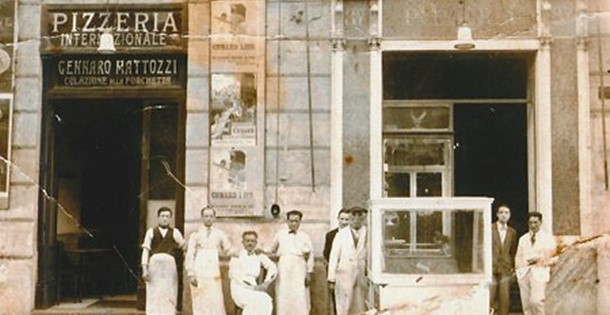There’s something about pizza that seems to fire the human imagination. Today, Americans have nearly unlimited choices of crusts and toppings.
If pizza lovers are willing to travel, they can get a pizza that’s deep fried in New York, or one that has a sweet potato crust in Los Angeles. Around the country, imaginative pizza artisans (pizzologists? pizzeristas?) are adding caviar, sushi, tandoori chicken, eggplant, pancetta, and smoked reindeer to their creations. And they’re offering unusual combinations, too, like strawberries and chicken, shrimp and guacamole, peaches and prosciutto, and caramelized onions, apples, and goat cheese.
Even pizza delivery has been upgraded. Impatient customers now can track the progress of their delivery by GPS, and Domino’s is testing delivery via driverless car.
All this creative thinking was inspired by a food that, for centuries, was just a flour crust with tomato slices and seasonings. The Saturday Evening Post has been tracing the evolution of the humble pizza for nearly 150 years.
The lowly tomato pie is first mentioned in our November 21, 1835, issue in a column from The Rural Economist trying to convince readers of the tomato’s merits: “There are few who relish it at first sight.” Despite Americans’ apparently chilly reception to the tomato, the author soldiers on: “Some will give a decided preference to a dish of tomato sauce or a tomato pie, when properly prepared, to any thing of the kind in the vegetable kingdom.”
Thirty-five years later, in 1870, the tomato-in-crust makes another appearance, although this recipe for tomato pie is most definitely more “pie” than “pizza.”
TOMATO PIE-Take two large ripe Feejee or other tomatoes of the same size, drop them into boiling water to remove the skin, then, with a sharp knife, cut them into thin slices, put the crust in an ordinary pie-pan, as for berry pie; cover the bottom with a layer of the tomatoes, then a layer of sugar and butter, then of tomatoes, then of sugar and butter as before; flavor with either lemon, orange peel, or nutmeg, to the taste. Cover with the top crust, bake, and bring to the table hot — (cold tomato pie is not good).
—October 8, 1870
This recipe was offered among several others, including cold partridge pie and chow chow. The author’s judgment is not to be trusted, however, based on his or her condemnation of cold pizza.
One of the earliest toppings of modern pizza was anchovies. Here is one recipe described in 1927:
A typical Tuscan menu was prepared and served by Giovanni Pisani, capo cuoco, or top chef, of one of Florence’s leading hotels. He started off with Pizza alla Paesana:
Prepare a large, flat brioche, unsweetened, about ten inches in diameter and an inch thick. Place the brioche in a shallow baking pan. On top of brioche place a layer of sliced tomatoes. Scatter on top of the tomatoes about ten or fifteen filets of anchovy. Over all place thin slices of cheese similar to Mozzarella. Spray a little olive oil over it, season with salt and pepper and cook in oven for about twenty minutes.”
—“A Cook’s Tour,” by restaurateur George Rector, December 3, 1927
The author notes that mozzarella was a cheese native to Italy and unlikely to be found in America.
Pizza might have remained an obscure Italian dish if American soldiers hadn’t discovered it during World War II. By 1948, it was even appearing in Post fiction. It now had a thinner crust, but it still had those anchovies:
The little old man stood behind a counter, kneading a ball of dough. Presently he began to stretch it with light, deft fingers until it was large and round and paper-thin. He brushed it with olive oil, sliced bits of hard white cheese over the surface and poured on a thick tomato sauce. Then he arranged anchovy fillets across the top and sprinkled freshly ground pepper and oregano over everything. With a long-handled, flat wooden shovel he lifted it up and slid it into the huge oven behind him. …
Tony fed the juke box another nickel, and they danced some more, until the pizza was baked to a delicate melting brown. Then Papa Joe slipped it onto a big tin plate and cut it quickly into large sections, and Tony showed her how to eat it, flipping the tip of the triangle back over the filling and holding it over a paper napkin.
—“The Low-Brow and the Lady,” by Gertrude Schweitzer, October 2, 1948
That same year, the Post’s sister publication, Country Gentleman, ran an article on backyard barbecuing and offered a recipe for “Campfire Pizza.”
Add ⅔ cup of milk or water to 1 cup of prepared biscuit mix, and beat 1 minute. Spread in a well-greased 10-inch skillet.
Cover with 1 cup of cooked tomatoes, and sprinkle with ½ cup of cubed American cheese, cup of grated Parmesan cheese and 4 cups of salad oil. Season with salt and pepper.
Cover and cook over a rather slow fire 20 to 25 minutes, or until lightly browned on the underside, and the cheese is melted. Cut into pie-shaped pieces for serving. Serve while still hot to 6 hungry campers.
—“Cook It Outdoors,” by Sara Hervey, September 1948
Ten years later, America had finally figured pizza out. A Post article by Richard Gehman in November 30, 1957, rhapsodizes over pizza,
…that wondrously flavorful, smoky-crusted, crisp or chewy pie of Neapolitan origin, bubbling with hot melted cheese and rich sauce from Italian plum tomatoes, dotted with bits of sizzling, succulent sausage or laced with soft, salty anchovies, sprinkled with parsley or oregano and dusted with musty Parmesan cheese.
Pizza had swept the nation, particularly Los Angeles, where restaurateur Patsy D’Amore prospered: “His restaurant, where Joe DiMaggio wooed Marilyn Monroe with pizza, is highly esteemed by movie stars. Frank Sinatra, whose fondness for pizza is almost legendary, goes there several nights a week.”
From such primitive beginnings, pizza has continued to evolve. The cooks of 150 years ago likely wouldn’t recognize the modern pizza, with toppings like rhubarb and barbecue sauce. And who knows what tomorrow’s adventurous chefs have planned? What we can predict is that if you have the perfect, crisp crust and some juicy, vine-ripe tomatoes, you can’t go too far wrong.
Featured image: Pizzeria in Napoli, circa 1910 (Wikimedia Commons)
Become a Saturday Evening Post member and enjoy unlimited access. Subscribe now




Comments
Thanks for the interesting read about some of the history of pizza. You mentioned that one of the earliest toppings was anchovies for modern pizzas. I’m kind of curious to learn what other toppings were tried around that time before anchovies.
I have owned for many years the painting titled “Haying Time” by W.H.D. Koehner which appeared on the cover April, 1921 Saturday Evening Post and I would like a copy if possible or information where I may come by one.
Cool article on hot American pizza pies Jeff, that in fact, CAN be great cool the next morning for breakfast. Some of the concoctions you mentioned in the 2nd paragraph are interesting, others not so much.
I’ve never been a fan of pizza with ham and pineapple. The worst thing imaginable though has to be anchovies. I don’t see how anyone could eat that. Although pizza isn’t a health food, it CAN be healthy and taste fantastic. Furthermore, it doesn’t even need to have cheese or meat. Don’t faint.
My own favorite is the Guinevere’s Garden Delight at Round Table Pizza. Thin crust with fire-roasted vegetables with plenty of tomato sauce. It’s the best, and you won’t miss the other one bit. Incredible pizza without the fat and cholesterol.
One-off places like the Pitfire Artisan Pizza Restaurant in North Hollywood makes a nice occasional place to go also. Domino’s Pizza has really improved a lot in recent years. Pizza Hut’s a little too greasy for my taste, and Papa John’s gave me a headache the one time I tried it. I wish there were more Numero Uno’s left, but they’ve largely died out, like Coco’s (not a pizza restaurant) out here.
It’s great to know the Post (in its archives) has its fingers in all kinds of American pies it serves up daily on this incredible website. Now go and have yourselves a healthy pizza. Trader Joe’s and Sprout’s carry Amy’s Pizza which is a great cheese-less vegetarian you can bake at home that’s delizioso!